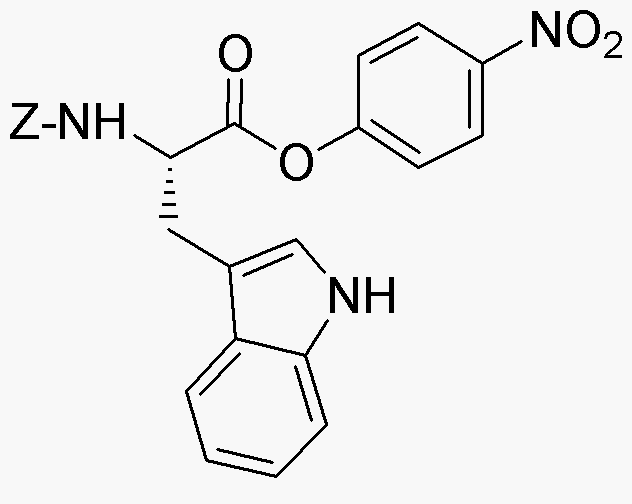Na-Z-L-tryptophan 4-nitrophenyl ester is widely utilized in research focused on:
- Biochemical Research: This compound serves as a substrate in enzyme assays, helping researchers study enzyme kinetics and mechanisms, particularly in the context of tryptophan metabolism.
- Drug Development: It is used in the synthesis of pharmaceuticals, particularly those targeting neurological disorders, due to its structural similarity to neurotransmitters.
- Protein Labeling: The compound can be employed in the labeling of proteins for tracking and imaging in cellular studies, enhancing our understanding of protein interactions.
- Analytical Chemistry: It acts as a standard in chromatographic techniques, aiding in the quantification of tryptophan derivatives in complex biological samples.
- Food Industry: This ester can be explored for its potential in flavor enhancement and as a precursor in the synthesis of food additives, contributing to improved taste profiles.
General Information
Properties
Safety and Regulations
Applications
Na-Z-L-tryptophan 4-nitrophenyl ester is widely utilized in research focused on:
- Biochemical Research: This compound serves as a substrate in enzyme assays, helping researchers study enzyme kinetics and mechanisms, particularly in the context of tryptophan metabolism.
- Drug Development: It is used in the synthesis of pharmaceuticals, particularly those targeting neurological disorders, due to its structural similarity to neurotransmitters.
- Protein Labeling: The compound can be employed in the labeling of proteins for tracking and imaging in cellular studies, enhancing our understanding of protein interactions.
- Analytical Chemistry: It acts as a standard in chromatographic techniques, aiding in the quantification of tryptophan derivatives in complex biological samples.
- Food Industry: This ester can be explored for its potential in flavor enhancement and as a precursor in the synthesis of food additives, contributing to improved taste profiles.
Documents
Safety Data Sheets (SDS)
The SDS provides comprehensive safety information on handling, storage, and disposal of the product.
Product Specification (PS)
The PS provides a comprehensive breakdown of the product’s properties, including chemical composition, physical state, purity, and storage requirements. It also details acceptable quality ranges and the product's intended applications.
Certificates of Analysis (COA)
Search for Certificates of Analysis (COA) by entering the products Lot Number. Lot and Batch Numbers can be found on a product’s label following the words ‘Lot’ or ‘Batch’.
*Catalog Number
*Lot Number
Certificates Of Origin (COO)
This COO confirms the country where the product was manufactured, and also details the materials and components used in it and whether it is derived from natural, synthetic, or other specific sources. This certificate may be required for customs, trade, and regulatory compliance.
*Catalog Number
*Lot Number
Safety Data Sheets (SDS)
The SDS provides comprehensive safety information on handling, storage, and disposal of the product.
DownloadProduct Specification (PS)
The PS provides a comprehensive breakdown of the product’s properties, including chemical composition, physical state, purity, and storage requirements. It also details acceptable quality ranges and the product's intended applications.
DownloadCertificates of Analysis (COA)
Search for Certificates of Analysis (COA) by entering the products Lot Number. Lot and Batch Numbers can be found on a product’s label following the words ‘Lot’ or ‘Batch’.
*Catalog Number
*Lot Number
Certificates Of Origin (COO)
This COO confirms the country where the product was manufactured, and also details the materials and components used in it and whether it is derived from natural, synthetic, or other specific sources. This certificate may be required for customs, trade, and regulatory compliance.


